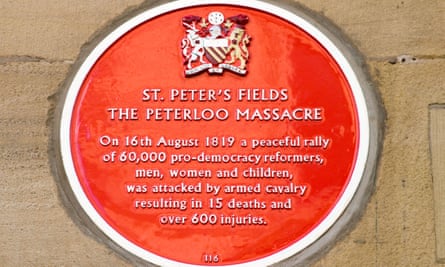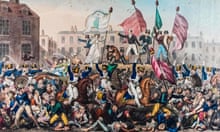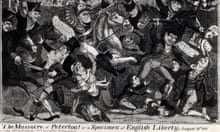At 8am on 16 August 1819, a bugle sounded at Barrowfields in Middleton, a town six miles north of Manchester. A crowd of 3,000 fell silent as Samuel Bamford, a radical reformer, poet and weaver, climbed on a chair to speak. They were, he bellowed, about to embark on “the most important meeting that had ever been held for parliamentary reform”.
There was to be no silly business. No sticks, no weapons, no back-chat. He admired their attire, “not even one who did not exhibit a white Sunday’s shirt”. Their conduct was to be “marked by a steadiness and seriousness befitting the occasion”, Bamford later recalled, casting shame upon their enemies, “who had always represented the reformers as a mob-like rabble”.
It was to be a historic day, as Bamford thought – though not for the reasons he hoped. By the time night fell, more than 650 people among a crowd of up to 60,000 in St Peter’s Field would be injured, among them 17 Moonrakers, as Middleton people have long been known. Worse, an estimated 18 people would lose their lives – bayoneted, sabred, trampled by cavalry – in what came to be known as the Peterloo massacre, a parodic comparison with the British victory at the Battle of Waterloo four years earlier.
They did not die in vain. Though Bamford did not live to see universal suffrage, which arrived in 1928, his bravery, and that of the other Peterloo protesters, laid the foundations for British democracy. The massacre also led to the launch of the Manchester Guardian – now the Guardian – after John Edward Taylor, a witness to the killing, watched in horror as the existing media colluded in an establishment cover-up which sought to blame the protesters for the bloodshed.
Two hundred years later, the Guardian has retraced Bamford’s steps to examine Peterloo’s legacy and explore whether the issues which led so many people to put their lives on the line still resonate today.
Still hungry
The fields where Bamford rallied the Middleton contingent 200 years ago now contain rows of two-up-two-down terraces, one marked with a blue plaque commemorating the Peterloo “demonstration” in support of votes for the working classes.
Modern-day Middleton is dominated by the inevitable big Tesco and a soulless shopping centre, built in the 1970s in what architects called “the American style”. The top floor now hosts the Lighthouse Project, a social enterprise that provides a safety net for the sort of people the local council used to help before its budget was cut by a quarter in the government’s austerity drive.
Half an hour before the Lighthouse opens, a queue has begun to form. The early birds are members of the Lighthouse Pantry, a food club for local people on low incomes, and competition is rife for the most prized items: a sirloin steak, a whole chicken, smoked salmon.

Raymond Potter, 59, a former asbestos stripper who can no longer work because of arthritis and depression, is a regular. He pays in £3.50 a week, and often receives more than £25 worth of food in return, donated by local supermarkets and FareShare, which distributes fresh food shortly before its sell-by date. Before the pantry opened last December, tea bags were such a luxury that Potter used each one twice. He could not afford enough milk for a whole bowl of cereal, so would dilute it with water.
Two hundred years earlier, people were going hungry in Middleton after the government introduced the Corn Laws, which imposed tariffs on imported grain, turning bread into the preserve of the rich. “We should have moved on by now, shouldn’t we?” says Michelle Porteus, a Pantry volunteer.
Unrepresented? Or just unimpressed?

When the Peterloo marchers reached Harpurhey, the halfway point to Manchester, they needed a rest. In his memoirs, Bamford recalled how “those who thought proper refreshed with a cup of prime ale from Sam Ogden’s tap”. Fighting for democracy was thirsty work.
In 1819, no one in Manchester or Salford had the vote, despite a population of 150,000. In 2019, most people in Harpurhey stay at home on election day by choice: this May, less than 20% of the electorate cast a ballot in a vote that returned Pat Karney, a Labour councillor since 1979, to the town hall.
Harpurhey is a friendly place of great deprivation: nine out of 10 households contain people who may need high or very high levels of support, according to the council. Yet despite this widespread dependency on the state, there is distrust of the politicians who run it.
At Harpurhey indoor market, William Porter, holds forth from his mobility scooter, proudly sporting an “old enough to know better” badge. “I don’t really vote. I don’t want to vote. I just can’t get my head around them [politicians],” says the 80-year-old former Grenadier Guard. “I don’t like liars, put it that way.”
The Peterloo protesters were angry that only the richest 10% of men in the country could vote, with a tiny elite getting ever richer while the poorest starved to death. Meanwhile in modern Manchester, an estimated 35% of children grow up in poverty, one of the highest rates of any local authority in England.
Yet a new generation of young people are determined for their voices to be heard. Anita Okunde, 15, from Middleton, represents Rochdale at the UK youth parliament. She says she would walk all the way into Manchester to campaign for better mental health provision for young people, or to demand action on knife crime.
One Friday each month her colleague Emma Greenwood, who represents Bury, skips school to take part in the Youth Strike. Up to a thousand young people gather in St Peter’s Square to demand government action on the climate emergency.
It sucks to not get a say, she says: “For me that’s heartbreaking, the fact I am going to have to grow up and inherit this world that other people have voted for. I don’t see why my age should dictate my ability to have a say in how my future should map out. I probably know more about politics than some 30-year-olds.”
The ‘precariat’ lives on

After their pints in Harpurhey, the Middleton marchers went through Collyhurst, now a big council estate soon to be “reimagined” by the council with help of the Far East Consortium, a Hong Kong-based development company.
They then approached Ancoats – once a densely populated slum and now one of the most fashionable areas of Manchester, where a two-bedroom loft in a converted factory built in 1825 is currently on sale for £600,000.
In Collyhurst, where significantly more residents are on jobseeker’s allowance than the national average, secure employment is thin on the ground.
The same was true in 1819 for Bamford and friends, according to Dr Janette Martin, curator of the Peterloo exhibition at the John Rylands library. “Early 19th-century handloom weavers and those employed in the cotton spinning mills were victims of periodic trade slumps, when large numbers would be thrown out of work, to be rehired weeks later as and when trade picked up and the manufacturers needed more workers. Remind you of the gig economy and the so-called precariat?”
Two hundred years later, an estimated 896,000 people in the UK are now employed on zero-hours contracts – up from 143,000 in 2008 – and Manchester’s streets are clogged up not with horses and carts, but Uber cabs and bicycles and motorbikes ridden by self-employed couriers working for Deliveroo and its rivals.
A few weeks before the 200th anniversary of the Peterloo massacre, the Radisson Blu hotel at Manchester airport advertised for a “monitoring and evaluation assistant” on zero hours.
“Have you got an eye for detail, do you want to add the finishing touch to something big? If you say Yes I Can! here at the Radisson Blu Hotel, were [sic] looking for ambitious people just like you!” gushed the job ad. There was a certain irony in that particular hotel chain advertising that sort of job at a time when Manchester is getting ready to mark the sacrifice working-class people made to fight for their rights. Just look at the red plaque outside its sister hotel the Radisson Blu Edwardian (formerly the Free Trade Hall): it is slap bang on the site of what was once St Peter’s Field, where the massacre took place.







